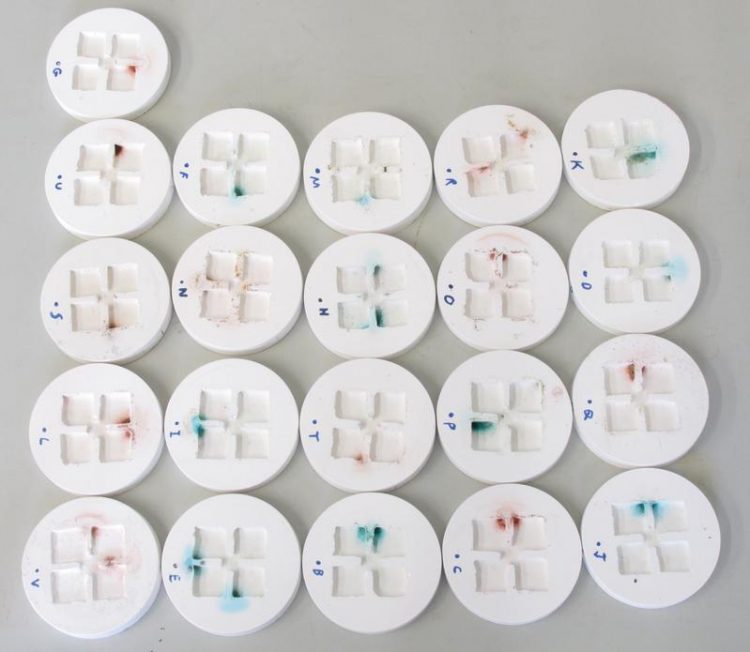Nest etiquette – where ants go when nature calls

Examples of ant toilets. Photo: Universität Regensburg
“For ants, which like us live in very dense communities, sanitation is a big problem”, says Dr. Tomer Czaczkes, who led the study. “Ants normally keep a very clean nest, and usually throw out dangerous rubbish, like food remains and corpses”.
But the scientists noticed something puzzling: they kept ants in white plaster nests, and distinct brown patches always formed in these nests. These brown patches looked suspiciously like faeces. So the scientists made lots of little white nests, and gave the ants sugar water coloured with either red or blue food colouring.
The results were clear: One or two corners of each nest started to change colour – and always the colour of the food the ants were fed.
The researchers are still not quite sure why the ants do this. Why don’t the ants just go outside to do their business? “It’s a puzzle” said Czaczkes. “Usually, ants keep their nest very clean – throwing out waste, and even sterilizing the nest with acid”.
The researchers suggest that perhaps the waste in fact might be useful. “Some insects use faeces for defence, as building materials, as manure for their crops, and even as way markings. Perhaps these toilets are also gardens for crops, or even stores for valuable nutrients.”
Maybe, though, the ants just don’t want to go outside to do their business. While the precise role of these toilets awaits discovery, we now know that ants are as organised in their private lives as they are above ground.
Further informations:
Manuscript title: Nest etiquette – where ants go when nature calls
Authors: Czaczkes, T.J., Heinze, J, & Ruther, J.
Institute: Universität Regensburg, Germany
Contact: tomer.czaczkes@ur.de
Publication: Public Library of Science One (PLOS One)
Publication date: February 18th 2015
Notes: Further images of ant toilets and more information available on request
Media Contact
More Information:
http://www.uni-regensburg.de/All latest news from the category: Life Sciences and Chemistry
Articles and reports from the Life Sciences and chemistry area deal with applied and basic research into modern biology, chemistry and human medicine.
Valuable information can be found on a range of life sciences fields including bacteriology, biochemistry, bionics, bioinformatics, biophysics, biotechnology, genetics, geobotany, human biology, marine biology, microbiology, molecular biology, cellular biology, zoology, bioinorganic chemistry, microchemistry and environmental chemistry.
Newest articles

Trotting robots reveal emergence of animal gait transitions
A four-legged robot trained with machine learning by EPFL researchers has learned to avoid falls by spontaneously switching between walking, trotting, and pronking – a milestone for roboticists as well…

Innovation promises to prevent power pole-top fires
Engineers in Australia have found a new way to make power-pole insulators resistant to fire and electrical sparking, promising to prevent dangerous pole-top fires and reduce blackouts. Pole-top fires pose…

Possible alternative to antibiotics produced by bacteria
Antibacterial substance from staphylococci discovered with new mechanism of action against natural competitors. Many bacteria produce substances to gain an advantage over competitors in their highly competitive natural environment. Researchers…





















